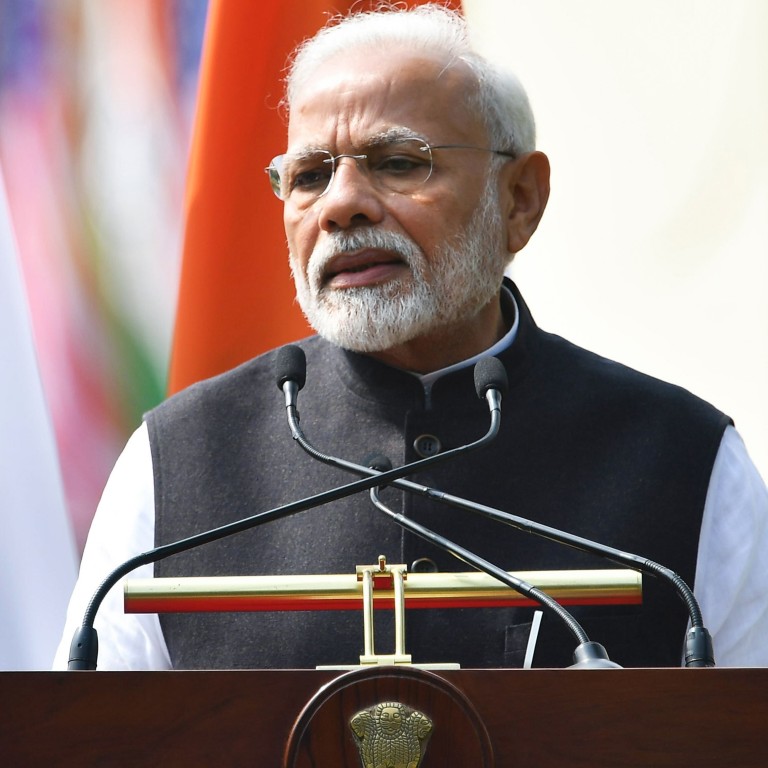
Could Narendra Modi’s ‘Gujarat model’ be to blame for the Indian state’s high coronavirus toll?
- Modi was Gujarat’s chief minister for 13 years and cited his model for economic growth and job creation as a reason to elect him prime minister
- But spending on health declined and the state now has India’s highest Covid-19 case-mortality ratio as it battles to cope with poor infrastructure and resources
With 1,280 deaths as of Monday, Gujarat has recorded the second-highest number of deaths among Indian states, and a case-mortality ratio of 6.22 – more than double the nationwide figure.

In Gujarat, there are just 0.33 hospital beds for 1,000 people, compared to the national average of 0.55 – which is already considered a poor standard.
“Gujarat has been spending less than one per cent on health, as a result of which the capacity of local health centres at the village and block levels/small towns/Mohalla clinics are very poorly equipped and poorly staffed. These are incapable of providing even minimum care to Covid-19 patients,” said Indira Hirway, director and professor of economics at the Centre for Development Alternatives in Ahmedabad.
Hirway, who wrote a book on the economic model, said the state gained in “economic growth at the cost of health, education, environment, employment [quality of employment] and overall well-being of the bottom sections of the society”.
For instance, Gujarat spent 4.4 per cent of its state GDP on health in 1999-2000 but after a decade under Modi’s leadership, this declined to 0.77 per cent by 2010.
“I believe that the focus on economic growth and neglect of developmental goals is something Gujarat has inherited from Modi. Modi was responsible for creating the hype of ‘Gujarat model’,” said Hirway.
Gujarat is currently behind Maharashtra – home to the financial capital Mumbai and its 20 million residents – in the country’s coronavirus death toll and is the second Indian state to exceed 1,000 deaths. Together, the two states account for 60 per cent of India’s Covid-19 fatalities. While Maharashtra has reported about 86,000 positive cases, Gujarat has confirmed just over 20,500.
An overwhelming percentage of Gujarat’s deaths have occurred in Ahmedabad, Gujarat’s largest city.
A special panel spent a month looking into Gujarat’s high mortality rate but the nine members publicly admitted there are no clear trends apart from the fact that 84 per cent of victims had co-morbidities or belonged to a vulnerable group such as the elderly, children or pregnant women.
“There is no permanent solution or answer, it is difficult to find reasons for why death incidents are high in Gujarat. We are trying to find out scientific reasons and where we find lapses, we rectify them,” panel member Dr Tejas Patel told reporters on Sunday.
India’s malls and restaurants reopen amid record surge in virus cases
To make matters worse, a number of controversies have been reported in local media, such as fake ventilators endorsed by the state’s chief minister, serious mix-ups of patients’ details and allegations of data manipulation.
In one episode of alleged negligence, the body of a 67-year-old Covid-19 victim was found at a bus station days after he was discharged from hospital, causing widespread outrage. In another incident, family members of a victim were incorrectly informed that the 71-year-old was doing well, hours before the cremation.

Reports of overburdened health care workers; poor health infrastructure such as a shortage of hospital beds and medical centres; and strategies including restrictive testing methods have caused further embarrassment to the officials handling the crisis.
On May 22, the Gujarat High Court publicly admonished the state government for its inept response to the pandemic, saying facilities at the Ahmedabad Civil Hospital were “pathetic … as good as a dungeon or maybe worse”. The court added that Gujarat had become one of the worst-hit states in the country due to a “lack of PPE [personal protective equipment], shortage of ventilators, ICUs and isolating wards”.
As India’s coronavirus deaths eclipse China’s, doctors see no end in sight
Observers said Modi’s policies in Gujarat of paying disproportionate attention to economic growth while neglecting social development are currently being replicated at the national level as a response to the virus outbreak.
Towards the end of Modi’s term as Gujarat’s chief minister, the state spent about 31 per cent of its total budget on the social sector – placing it in 17th position among the 18 largest Indian states, according to figures from the central bank.
Critics point out that India’s budgetary expenditure on social services such as health care and education leaves a lot to be desired, and is the lowest compared to neighbouring countries like Sri Lanka or Bhutan.
No money, no food, far from home. In India, millions just like them
Sanjeev Kumar, senior programme manager at the public research university Tata Institute of Social Sciences, said the Indian government’s prevailing policies have troublingly mirrored the “Gujarat model” since Modi came to power in 2014.
“The reduced spending on health amenities or in higher education [by the central government] is a reflection of the ‘Gujarat model’ of development,” said Kumar.

